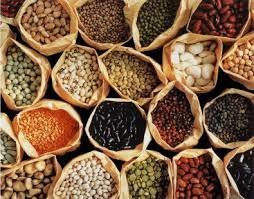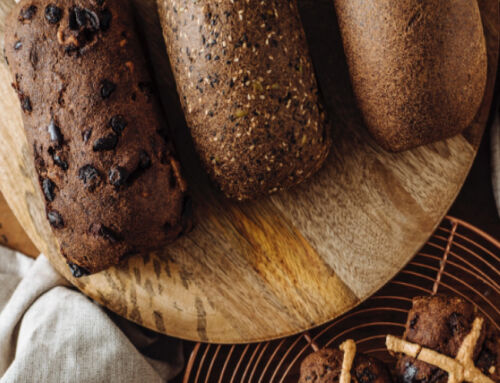There are so many reasons to eat more meat-free meals: they are almost always cheaper, lower in kilojoules and better for the environment. Vegetarianism has also been associated with lowering cholesterol, blood pressure and the risk of heart disease!
Even if you are a meat-lover, it is beneficial to have a couple of meat-free days a week (particularly red meat) to give your gut a break. It’s also important to get protein from a wide variety of foods to reduce your risk of becoming intolerant to any one source (like eggs or milk).
One thing you should be wary of is that many vegetarian sources of protein are not “complete”. There are 20 different amino acids that can form a protein, and nine that the body can’t produce on its own (known as essential amino acids). In order to be considered “complete,” a protein must contain all nine essential amino acids in roughly equal amounts.
But don’t worry, it’s not as difficult as it sounds. Most plant-based diets contain such a wide variety of amino acid profiles that you are virtually guaranteed to get all of your amino acids with very little effort.
As you can see, we often rely on animal sources of protein because they are easy, but here are five of my favourite meat-free proteins that you can use every day.
Chickpeas
Chickpeas (sometimes known as garbanzo beans) are part of the legume family, a food group Australians should be eating a LOT more of. Chickpeas are rich in protein (19g per 100), however the protein is not complete.
I love chickpeas because they are so versatile – add cooked chickpeas to your salad, blend them into hummus and have as a dip (or add a dollop in your salad too), put them in curries, make them into flatbread, or even make pancakes with them!
Mung Beans
These small green legumes might not have the best-sounding name, but mung beans pack a protein punch (24g per 100g) and are rich in lycine, an essential amino acid and building block of protein that helps with the building of lean muscle. They are also an excellent source of fibre, antioxidents and phytonutrients. Mung beans aren’t that popular in Australia, but they have been part of traditional Ayurvedic diets in India for thousands of years.
You can get them fresh from most grocers or supermarkets in their sprouted form (perfect for salads or to decorate your dish) and you can also buy them dry which makes them great for soups and stews and dhal – dishes that can be made on a Sunday and eaten throughout the week.
Quinoa
Quinoa (pronounced KEEN-wah) as we buy it is actually the seed of a grain crop. It was known as “the gold of the Incas” as they used it to increase the stamina of their warriors. And it’s no wonder! Quinoa contains 13g of protein per 100g and is a “complete protein,” meaning it contains all nine essential amino acids. Just remember to wash before using – this will remove any traces of the saponin (a naturally-occurring chemical that has a bitter soapy taste).
There are so many ways to eat quinoa – use it as a substitute for rice, put it in salads, make it into porridge, put it in soup, use it as a crust on salmon or as a pizza base!
Chia seeds
Chia has been promoted as a ‘superfood’ in recent years, but does it deserve its status? In my opinion, yes!
Chia seeds come from the desert plant Salvia hispanica, a member of the mint family. They come in black or white, and although small, they pack a big nutritional punch. This complete protein contains a whopping 17g of protein per 100g (complete) and is also unusually high in omega-3 fatty acids (18%), which are essential for heart health and brain function. Chia is packed with fibre (34%), calcium (631mg per 100g or five times the level in milk), minerals like iron, magnesium and zinc, and is gluten-free to boot. Importantly, chia seeds are also high in antioxidants such as flavonoids, which inhibit cancer development and stabilize highly-reactive free radicals. You can now understand why research has shown chia can help to achieve joint, heart and brain health, weight management and provide longer-lasting energy.
These seeds are extremely versatile and easy to include in your diet – sprinkle on your cereal, make into porridge, pop in your pikelets, have a chia sundae for breakfast or snack, make a chia pudding, or try chia and almond bread. Chia can also be used instead of egg as a binder in recipes. 1 egg = 1 tablespoon of chia seeds with 3 tablespoons of water. Mix for several minutes until you get a smooth consistency without clumps.
Fermented Soy Products
Soy is another complete protein and is my go-to substitute for meat in dishes, however it has copped a pretty bad wrap lately. The concerns relate to soy’s phytoestrogens, a compound that mimics estrogen in the body. But rest assured, soy is not source of estrogen. If you are worried, give tofu a miss and opt for fermented, organic and non-GMO sources. Fermentation has been shown to reduce the level of phytoestrogens in soy by as much as a third. Fermented products include tamari (variety of soy sauce that is MSG-free), miso, tempeh, and (for the more daring among us) natto.
Tofu is the best-known soy product, and is made from soybean curds pressed into white blocks to make a protein-rich meat alternative (10g per 100g) often used in stir-frys. However it is not fermented and can be quite processed, so it’s best not to overdo it.
I prefer to use tempeh, which is made from fermented soybeans. It is firmer and chewier than tofu, and contains more protein (19g per 100g). It has a nutty, slightly sweet flavour which is perfect for stir-frys, baking, steaming or grilling. It even makes a delicious meat-ball alternative! It also absorbs the flavour of whatever it is cooked with, making it just as versatile as tofu.
Another fermented soybean product that you should include in your diet is natto, which packs a protein punch at 18g per 100g. It looks similar to kidney beans and is a Japanese favourite at breakfast time, eaten with sushi rice or in a maki roll. It is a bit harder to find, but try your local Asian grocer.
Finally, miso is a traditional Japanese seasoning made from fermented soybeans which is a complete source of protein (12g per 100g). This thick salty paste can be used for sauces, spreads, glazes and can be made into a soup. While it may have a high sodium content, recent research has shown that miso does not appear to affect our cardiovascular system in the way that other high-sodium foods sometimes can. It’s also a great source of iron, calcium, potassium, B vitamins and polyunsaturated fats, which lower ‘bad’ cholesterol.
Miso’s health benefits don’t stop there. The fermentation process required to make miso results in increased lactobacilli, which facilitates the absorption of nutrients while promoting a healthy pH in the digestive system. Finally, it contains the isoflavon Genistein, which has been shown to inhibit the uncontrolled growth and spread of cancer cells, as well as eliminating free radicals.
As you can see, there’s definitely no shortage of protein when you eat a plant-based diet.
Why not consider giving Meat-free Mondays a try – it’s good for your gut, your overall health, and the planet!
Yours in Health,
Peter Mullen
Have you been living with a health condition for years that hasn’t responded to conventional medicine effectively? Or are you simply not feeling your best?





